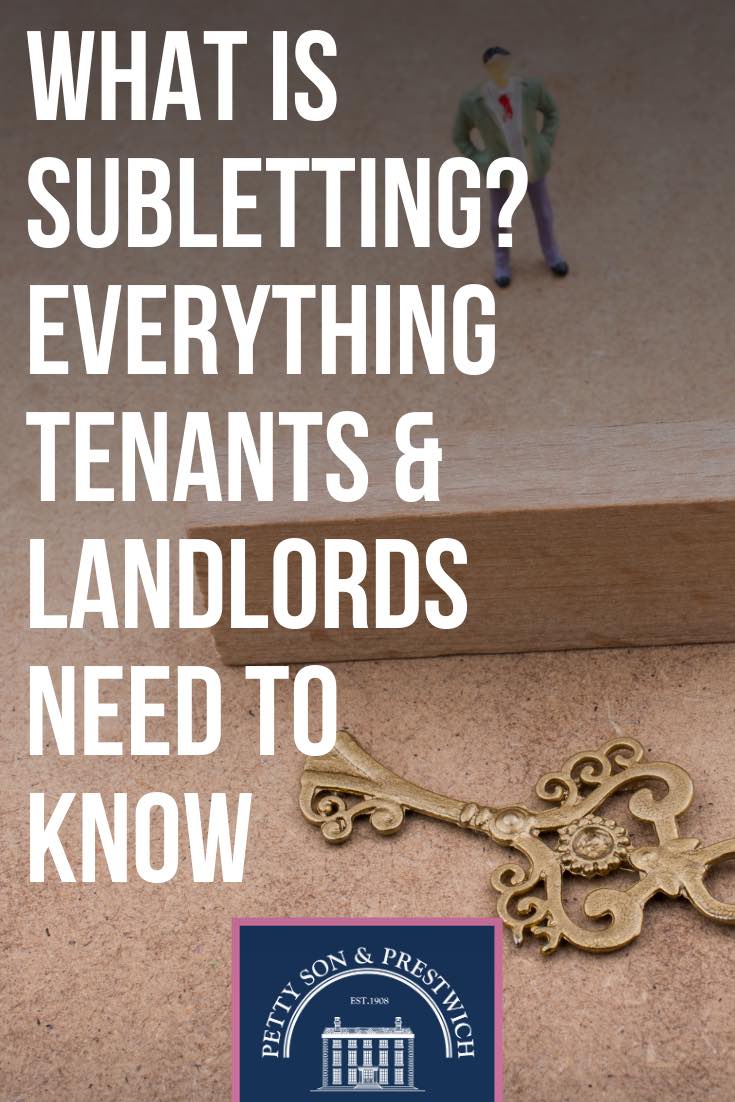Subletting is a pretty divisive practice, yet it’s surprisingly common across the UK. While some landlords welcome subletting, others will do all they can to prevent a sublet happening in their property.
The question is, who’s right?
What is subletting?
Before we move on to the nitty-gritty, let’s spell out exactly what subletting is. In its most basic form, a sublet comes about when a tenant rents a property from a landlord and then decides to take on another tenant themselves.
Straightforward stuff.
Where the waters become murky is when mesne tenants (meaning the original tenants) aren’t upfront about what they’re doing and fail to get permission to sublet from their landlord in advance. Naturally, this isn’t the way to go about things, and in many instances it isn’t even necessary for tenants to be so deceitful.
In some instances, tenants may well be entitled to sublet, providing they are honest and ask for permission beforehand. Put simply, subletting doesn’t need to be quite as cloak and dagger as many tenants make it and they are putting their homes at risk by doing so.
Is subletting illegal?

After reading the section above, you’d be forgiven for thinking the ‘Is subletting illegal?’ question had already been answered. As with so many other property law related queries, however, things aren’t quite as cut and dried as all that and there are numerous shades of grey sitting between the black and white poles of right and wrong.
In short, subletting can be both legal and illegal. As we’ll find out later in this article, the crux of the sublets legality will rest upon permission and how the tenants come to take on a sub-tenant.
Rights of tenants to sublet their home
In terms of a tenant’s right to sublet their home, much will depend upon the type of tenant they are. Assured shorthold tenants rights to sublet will differ to the rights of demoted and family intervention tenants, for example, so there’s no clear cut, one-size-fits-all answer, unfortunately.
That said, there is one document that will generally hold the answer for every tenant, regardless of their situation: the tenancy agreement. Tenancy agreements will often spell out exactly where tenants stand, covering what is and what isn’t acceptable in terms of subletting.
Why would tenants want to sublet?

There are multiple reasons for tenants to take on a sub-tenant, but finance is by far the most common. As we all know, circumstances can change, and when that difference is economic in nature, tenants can often find themselves in a sticky situation...namely not being able to meet their rent payments. In instances such as this, subletting offers an obvious solution.
Taking in a sub-tenant can help the original tenant meet the rent and pay the bills, thus lightening the load. However, subletting isn’t always purely financial. Many will feel happier sharing than living alone, and a sublet can provide company and safety to anyone who feels uneasy being by themselves.
What is considered unlawful subletting?
As we’ve already seen, subletting can fall on both sides of the legal / illegal fence, but what actually constitutes unlawful subletting?
Unsurprisingly, permission plays a major role here: both in whether it has been asked for at all or whether the denial of permission has been ignored. In the vast majority of cases, should a tenant choose either of these routes, the tenancy agreement would have been broken, thus deeming the sublet unlawful.
Other examples of unlawful subletting include those who are in social housing with stipulations preventing them from taking on their own tenants and even those who have bought part of the property through the shared ownership scheme. If the housing association states that subletting isn’t allowed, they mean what they say and will come down hard on those who breach the agreement.
What should landlords do if a tenant asks to sublet?

Obviously, this will need to be dealt with on a case by case basis and cannot be answered in simple terms. As we’ve already mentioned in this piece, some landlords welcome subletting, while others are flat out against it. Only you will know what camp you’re in.
There are, however, some things to bear in mind here, with the most important being the quality of the tenant. If you deem them to be good tenants and know they have genuinely fallen on hard times, you’ll probably act more favourably towards them than someone who is clearly trying to pull the wool over your eyes.
You should also consider the possibility that your tenant may wish to move on in the future, while the sub-tenant might want to stay. This very rarely ends well, and can ultimately result in you, the landlord, having to follow through with an eviction notice on someone you never even let to in the first place!
Whose responsibility is the sub-tenant?
The above scenario brings up the question of who is responsible for the sub-tenant? Is it the landlord or the original tenant?
In most instances, the landlord will not be deemed to have a legal relationship with the sub-tenant, as they were taken on by the mesne tenant. However, landlords need to be careful not to inadvertently create a legal relationship with the subtenant. Many have fallen foul of this by, for example, collecting rent directly from the subtenant, thus creating a direct link between them.
So, providing you don’t do anything that will tie you to the sub-tenant, they will be the responsibility of your tenant - the original person you let the property to. This makes them your tenant’s lodger and nothing more. While they will still have lodger’s rights, these will be actionable against the tenant, who effectively becomes the sub-tenants landlord in relation to the sublet.
Can a tenant be prevented from subletting?

Landlords can stop their tenants from subletting, but not retrospectively. It must be a decision they make prior to letting out the home and there must be a specific clause in the tenancy agreement forbidding subletting.
If the tenancy agreement doesn’t explicitly state that subletting is forbidden, the tenant may be able to argue their right to sublet, especially those considered secure and flexible tenants, as landlords cannot unreasonably deny consent to a tenant’s request to sublet under these circumstances.
What happens if a tenant sublets your property without permission?
Obviously, this is a nightmare scenario for any landlord, and it can happen in a couple of different ways.
The first, and probably most straightforward to accept and deal with, is where your tenant takes someone in as a sub-tenant whilst they continue to live in the property themselves.
The second is far worse.
A growing number of landlords have found that they’ve let a property out to a tenant in good faith, only to realise further down the line that they’ve then gone on to let each room out individually to different tenants for profit. The situation is further exacerbated by the shady tenants desire to maximise their profits by packing as many sub-tenants in as possible.
In either case, the first course of action is to talk to your tenant. Believe it or not, many cases are resolved by simply opening up dialogue with them, so this should always be your initial move.
If you cannot reach a satisfactory outcome with the mesne tenant, then you should talk to the sub-tenants to see if an agreement can be struck with them. You may find that you can explain the situation and they’ll move on, or you could agree for them to remain and have the initial tenancy negated and transferred to them.
You shouldn’t, however, accept any money from the sub-tenants until due process has been taken care of and they are legally your tenants and the original tenant has been removed. Remember, accepting payment of any kind could result in the courts deeming this as a new tenancy agreement being struck.
If no agreement can be reached with either the mesne or the sub-tenant, you will need to enforce the clause in your tenancy agreement. Make it clear to your tenant you intend to serve notice if the situation is not rectified as they have breached the contract you have with them.
Should you find yourself in a situation where there is no clause in the tenancy agreement, you should explore your lender’s criteria to see if there’s a condition in place that prohibits subletting. This will give you grounds to ask the original tenant to ask the sub-tenant to leave. Similar clauses can often be found in insurance policies, too, so check those as well.
From there, your options become slim, with serving a Section 8 Notice your only real course of action. This would be under Ground 12, where the tenant is deemed to have breached any term in their tenancy agreement.
Are there any downsides or risks to allowing subletting?
As mentioned above, both mortgage lenders and insurance providers can be against landlords accepting subletting, so you’ll obviously need to clarify your position with them before accepting any request from your tenant to sublet. Failing to do so could land you in hot water and result in a voided contract.
Another potential risk to consider is what happens when the tenancy comes to an end. Many landlords have found themselves in sticky situations where their tenant wants to move on but the subtenant has no desire to do so. As one can imagine, trying to evict someone with whom you don’t even have a tenancy agreement can get a little tricky, to say the least.
Subletting advice for landlords
While all of the above may leave you feeling cold towards subletting, it’s important to remember that plenty of landlords happily agree to it without issue. There are, in fact, some instances where allowing subletting to go ahead makes good business sense, but you need to be clear on some major points to ensure you’re protected should the worst happen.
Key amongst these is getting the tenancy agreement right, as failing to do so can cause all sorts of headaches further down the line. Make sure there’s a clause covering subletting in there and that it’s clear what is and what isn’t allowed within it.
With an airtight agreement in place, the next step is to get your tenant referencing right. You’d be amazed at how often this part of the tenancy process gets rushed or overlooked entirely. Don’t be complacent here. Do your due diligence and try to ensure you end up with good tenants now rather than big problems later on.
It’s also vital to keep your communication channels open and generally be a good landlord to your tenants. If they feel they can trust you and you work on building mutual respect with them, the likelihood of an unlawful sublet occurring drops dramatically. They are much more likely to open up should their circumstances change, rather than go down the route of illegally subletting behind your back if you’ve previously built a decent relationship with them.
Carrying out regular property inspections will also help you spot any signs that things aren’t quite as they should be. They’ll also act as a deterrent, too, so make sure these are made clear to your tenant and that you actually follow through with them whenever they’re due to take place.
Finally, if all that seems too much like hard work, you could consider property management from a reputable letting agent in your area. Here at Petty’s, our lettings team go above and beyond to ensure all of our landlord’s investments are taken care of and that no breaches of contract occur.
If you’re a landlord in East London or West Essex and would like to find out exactly what we can do for you and your business, give us a call. Our friendly experts are always on hand to offer advice and guidance, so do feel free to reach out and speak to them about which of our property management packages will best suit your needs.

Disclaimer: The information contained in this post and any other found on pettyson.co.uk is for informational purposes only and does not constitute financial or legal advice.